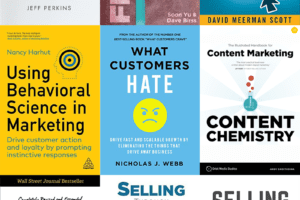???? Episode 81 of Yes, and Marketing
Few areas of marketing are more critical to success than pricing, so it’s truly shocking how few true pricing experts exist. (And how infrequently marketers talk about it.)
In this episode, Steve talks with Patrick Campbell, the CEO of Profitwell. Profitwell builds revenue automation tools, and Patrick is an expert in pricing, churn, retention, and all things SaaS. They covered:
- How to set your prices (and how not to)
- Why Freemium has to be your best product
- What “real demand” looks like
- Taking retention strategies to the next level
- Why he currently lives in a van (sort of)
Tap through the chapters above to listen or read on for our highlights from the conversation.
???? Who is Patrick Campbell?
Name: Patrick Campbell
What he does: Co-founder and CEO of Profitwell.
Find Patrick on the web: Profitwell | LinkedIn | Twitter
Get smart: “Pricing is so much more than the number. It’s packaging, add-ons, localization, discount strategy, term strategy—all of these different things.”
???? Top Takeaway
The email to send when you’re raising prices
Telling your customers about a price change is likely your least favorite email to write. As someone who understands pricing better than just about anyone in the industry, however, Patrick has formulated the ideal email to communicate a price increase in a way that’s clear, thoughtful, and will result in less churn.
- Remind them of the value you’ve provided.
Use real data, Patrick says, to show the total value you’ve provided over a certain period of time. Depending on your business, that might be the amount of contacts you’ve provided, the number of blog posts you’ve written, the amount of time or the amount of money you’ve saved them, etc.
2. Remind them of new features.
“I want to remind them of, ‘Hey, you know that feature you requested?’’—and this can get a little complicated, but you want to do the work upfront because it pays off—’that feature you requested, it’s now in your account and you use it daily,’” Patrick explains.
Talking about new features shows your customers that there’s momentum in your product, which helps make the idea of a price increase more palatable.
3. Tie the price increase to the value they receive.
Patrick’s example line: ”For us to continue to invest in making the product better for you, we need to increase our prices.”
This puts the price in in the context of them and the value that they’re going to get, while clearly communicating that there will be an increase.
4. Reward their loyalty with a legacy discount.
While new customers will start seeing increased prices immediately, allow your existing customers to stay at the current price for a set amount of time.
In action, this might sound like “Because you’ve been so loyal and you’ve been with us for the past four years, we’re going to give you six months of no price increase.”
“It’s almost like a promotion or a discount I’m giving them,” Patrick adds. “It’s called the legacy discount.”
5. The P.S.
Patrick’s favorite part is the P.S. where he says, “‘If this materially impacts your business’—or ‘life,’ if you’re a consumer product—‘please let us know and we’ll work something out.’”
Most people, he explains, will understand and accept the price increase, even if they don’t like it. If anyone truly is going through hard times, however, they can reach out. “That’s a great brand moment where you can go, ‘Oh, don’t worry. We’ll reach out in a year. You do your thing, you get back on your feet. Don’t worry about it at all.’”
???? Episode Highlights
Read verbatim excerpts from our interview with Patrick Campbell.
Don’t use competitor data to set your pricing.
“You’re assuming you’re selling the exact same product in the exact same market—probably not true. You’re also assuming your competitors have done their homework. As someone who’s studied how often people actually look at their pricing, I guarantee you, your competitor has not done their homework, so don’t copy from the dumb kid in class.”
Specifics don’t matter early on.
“The most important thing when you are doing your pricing, probably up until like 70, 80 million in revenue, is do not care about $19 versus $20 versus $21. Do not care about that level of specificity.
You should know, am I a $10 product? Am I a $100 product? Am I a $1000 product? And then as you grow, maybe you want to know, well, I know I’m a $10 product, but am I a 5 or a 10 or a 15?”
Measure twice, cut once.
“Knowing who you’re supposed to sell to is so important. I just see so many companies—that are fantastic—have to guess and check their way to this answer, rather than doing a little bit of research to know. It’s basically ‘Measure twice, cut once.’”
Know your pricing power.
“If you never get push back and you never have to objection handle, that’s when I would do a little pricing research and I’d be like, cool, what’s our pricing power? Meaning, how high can we go for the type of buyer we’re going after? Because I’ve seen plenty of companies… where all of a sudden it’s like they go from $50 to $500 because they finally did the research.
And not only does their revenue per customer go up, but their acquisition and their conversion rates go up because people start taking the product seriously. They thought, ‘Oh, they can’t do this for the price that they’re offering,’ which is a huge signal in the market.”
Real demand has curves.
“When you look at a lifetime of a customer, yes, if you lower your price, you will get more sign-ups, but there’ll be a lot more churn in a lot of businesses as well. And you’re also not necessarily getting the right type of customer because what people don’t tell you about demand curves, unless you take more of an advanced class, is it’s not a straight line, Some of them have curves, or things like pregnant curves where demand drops when the price is too low—there’s all kinds of things when it comes to actual demand curves within a business, and that’s why it’s important to do your homework.”
Price changes will cause churn, but that’s okay.
“The thing you gotta keep in mind, no matter the type of pricing change you do—especially a price point increase, but even a decrease—you will see some people cancel. It’s very similar to sending receipts. If you sent all of your receipts on one day, that would be your highest day of churn because you’re reminding people they’re paying for the product.
…But normally what happens, even with the price increase, you’ll have some people leave and then all of a sudden your churn will go down past the point where it was originally because you got rid of the people who are already on the fence and probably going to churn in the next few months anyways.”
After your initial email, don’t go overboard on price increase communications.
“When that increase comes for those customers [six months after telling them about it], I try not to go overboard with it. I just take it off their invoice. I don’t remind them again that their price went up. This is a big mistake I think a lot of companies do. It’s like, stop making it a thing.
…Be very transparent, be very clear, put it on their invoice so it says ‘legacy six month discount’—be specific—and then after the six months, it drops off.”
Churn isn’t forever.
“Too many companies don’t think about growth as a multi-move game. They think about it as like, ‘Well, you’re here and now you’re gone, get out of my life.’ And it’s like, people come back all the time. Over a year, for a lot of businesses, you’ll see like somewhere between 20 and 30 percent of churned customers come back because they’re aware of you, and a lot of them leave for reasons not even having to do with you.”
Your off-boarding matters.
“If I have to say, ‘Hey guys, we’re going to do this different strategy,’ you have a choice. You can be an ass to us and be like, ‘Oh fine, bye. We’re deleting everything today”—and some of that stuff is okay, like, maybe I want a maintenance plan, right? We’re going to have a maintenance plan where we’re going to save everything. It’s only like 10 bucks a month. It’s very cheap, but we’re going to save everything. I’ll take a downgrade over a churn.
But a lot of people they’ll go, ‘We’re going to delete everything if you cancel and like, blah, blah, blah.’ And I’m like, ‘Okay, I don’t want to work with you again.’ Or at least it’s commoditized enough that when I want to come back, I’m now gonna go talk to all your competitors as well, and I’m gonna reevaluate the whole thing.
Whereas if I have good off-boarding—that yes, had a little bit of gives and gets because I think that’s important—all of a sudden I’m going to go, ‘Okay well, they were good. Let’s just start back up with them.’”
????️ Patrick Campbell Quotes
“Most of us are businesses where our costs relative to the value we’re providing is very different.”
“There’s this big misconception that freemium can be a worse product. I actually think it needs to be a better product than the paid competition.”
“If you’re not in a very commoditized business, the worst data to get is competitor data and cost data.”
“Most of us don’t take our ideal customer profiles to the degree that’s necessary to 1) make better decisions, and 2) make sure that we can settle arguments or help arguments internally.”
“Pricing is so much more than the number. It’s packaging, add-ons, localization, discount strategy, term strategy—all of these different things.”
“If you sent all of your receipts on one day, that would be your highest day of churn because you’re reminding people they’re paying for the product.”
“If you stop sending receipts, you would see lower churn, but you’d probably have worse refunds, chargebacks, and also really bad reactivations.”
“Credit card failure is actually the largest single bucket of lost customers, if you’re a credit card based business.”
???? Learn More
Check out Profitwell’s media network, Recur, for more content on subscription businesses, retention, and pricing.



